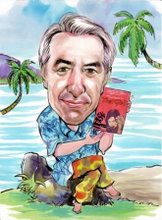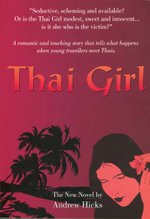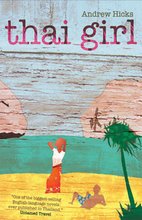
The totally nude image of a sexy and delicious Thai girl on the front cover of the DK Books 1985 edition of Jack Reynolds' extremely seminal novel, "A Woman of Bangkok" would have deeply shocked Vilai, The White Leopard, the aforesaid Bangkok woman and dance hall hostess, the posturing anti-heroine of Reynolds' story. She would never have let herself be seen either in daylight or darkness unless elegantly but alluringly attired, especially at the dance hall. And to be seen in the nude, let alone be photographed, and then to be manhandled for free by an infinite number of smutty book readers would never have been allowed by The Number One Bad Girl of Bangkok. Unless of course she were quite exceptionally well compensated.
(And now a tip... a copy of this rare edition of the book is available at leading second-hand book dealers, DASA on Sukumvit road near the Emporium, but it won't be for long.)

But did The White Leopard really exist and has she ever shown her face since the book came out? What does Trink think? Read on!
The Plot Thickens
My solitary quest to discover the life of ‘Jack Reynolds’, the shadowy author of the 1956 novel, “A Woman of Bangkok” is continuing apace and I’m thoroughly enjoying it. It has become totally absorbing as each new bit of information comes to light, but there are so many leads to follow up that I’m overwhelmed.
If you scan down this article, you’ll find a list of key questions and with these I really do need your help, especially as I am not in Bangkok to do any of the hands on research.
Can you answer any of the questions for me? Could you yourself go and dig out some of the answers even, in a common effort to produce a brief account of Jack’s life? (Eg Employment records at UNICEF or The Bangkok Post.)
Most dramatically, I now have a photo of the Christian headstone to Jack’s grave, though I don’t know yet where it is exactly. It shows him as Jack Reynolds Jones, his wife Wanpen Muthikul Jones. He was born 1st June 1913 and he died on 8th September 1984, just over twenty five years ago, aged seventy one. A photograph shows a man with glasses, dark hair and a square lantern jaw. An empty space awaits the picture of his widow.
My previous article below describes the extraordinary phenomenon of this talented writer producing a first novel about the very accommodating woman of Bangkok which bursts upon the world just a year after Frank Mason’s, “The World of Suzy Wong”. The book reputedly sold more than a million copies, but apart from one serious non-fiction work about China, its author then disappears almost without trace. The people around him would of course deny this but in truth there is no public record of his life. I’m now trying to find those who did know him and to fill the void with a short history of Jack Reynolds. The few thousand words I plan seem to be growing though as the information flows in.
One new and unique source is the unpublished book written by pioneering Oxfam stalwart, Bernard Llewellyn in the late eighties. His remarkable manuscript book called, “A Traveller in the Third World – The Memoirs of An Itinerant Do-Gooder, 1940-1982” should definitely see the light of day, though that’s another story. The point is that outside of his family and a few friends from Oxfam, I am privileged to be the first person to read it… and there are four fascinating passages about Jack. Bernard and Jack worked together in the Friends Ambulance Unit in China during the war years and with much in common as the England born sons of Christian Ministers with Welsh origins and as conscientious objectors, they quickly became firm friends.
One rather poignant passage in the book goes some way towards explaining Jack’s failure to produce another novel.
Llewellyn writes that when he visited Jack in Bangkok in 1957, the year after “A Woman of Bangkok” was published, Jack, “was making heavy weather of his more serious work. His novel had taken months to write and rewrite; but in 1957 “A Woman of Bangkok” had finally appeared. He wrote it using his mother’s maiden name: the nom de plume, Jack Reynolds. Though we did not know it in 1957, this was to be Jack’s sole full-length novel. Some shorter pieces were later to be collected and produced in paper-back [this was presumably “Daughters of an Ancient Race”, Heinemann 1974] but nothing was to cap his early achievement.
The picaresque adventures along Chinese and Thai roads which made his letters such fun to receive for the most part never found their way into print ; though he was to send me in the sixties a summary of the plots and the characters around which nine separate books were to be written. But Jack could never quite settle to complete them one at a time and, in his mind, one story merged into another and he wrote and rewrote until the accumulation of material confronted him with an impossible task. Nor was the literary problem the only thing on his mind. Family life and the problem of earning a living in a country of infinite distractions held back the flowering of what seemed to me a prodigious talent.”
Jack’s protagonist in the novel, Reginald Joyce was a tormented character torn between the biblical strictures instilled into him by his Christian Minister father and his own more tearaway tendencies. In the book Reggie escapes his upbringing in Bangkok by taking to booze and easy women with a huge appetite, but all the time racked with guilt and recriminations.
Given the autobiographical implications of the novel, perhaps Jack too was a complex character and I hope his old friends can tell me more. I have received two personal reminiscences suggesting that in his later years his joy in writing had turned to dust and that he suffered a terminal case of writer’s block. There was also mention of an article called something like, “The Ghost of Soi ??” that appeared somewhere in the Bangkok media in which his picture showed him as looking thin and with a whispy grey beard.
Can anyone locate this article?
The great strength of Jack’s book is that it is so precisely observed from life. His picture of Bangkok and of Reggie’s arduous drives up to Korat are passionate and vivid. Thus one inevitably asks, who was the inspiration for Vilai, ‘the woman of Bangkok’, known otherwise as The White Leopard of the Bolero dance hall and the bitter rival of The Black Leopard. Were they too and the Bolero itself drawn from life and who exactly were they?
It seems I may now have an answer. My informant, now in his nineties, tells me as follows (after some editing).
“The Bolero was the Cathay, an open air Bangkok dance hall with a concrete floor and Mekhong and Singha on offer. It had a roof, a bit of a bandstand and sometimes serviceable toilets. There was also Thai food available. The girls sold drinks and tickets to dance with them. It was mostly Thai men as there were very few farang then. At both the Cathay and the Hoi Ten Lao, a famous six storey restaurant with a nightclub on the top floor, the White Tiger and the Black Tiger were the mainstays. (They were of course Jack’s inspiration for his characters in the ‘Bolero’.) The Black, as I think it was, moved on and set up shop elsewhere until the nineties. One of the Tigers, I think the White, got sick and spent all her savings on doctors but died anyway in the sixties.”
A number of sources, based probably on published interviews that Jack later gave, say that he and the White Tiger were firm friends and saw each other every New Year for many years and that it was a probem for him keeping her identity private. However, later on when Jack was in declining health, she had eventually failed to show up to see him.
About six years ago (?), Bernard Trink, presumably in his Nite Owl column in the Bangkok Post, said he saw the White one in a Sukhumvit bar playing pool. This is what he said.
“If you didn’t read Jack Reynolds’ “A Woman of Bangkok”, long considered the literary classic about the night life of the metropolis, skip this item. Believe it or not, its White Leopard heroine was seen shooting pool a week ago at Rajah Hotel’s Hillary Bar (Soi 4 off Sukhumvit). Her name, incidentally, is Muck. And her personality is much the same as when Jack wrote about her.”
It would be fascinating to resolve this mystery though the ‘facts’ must by their nature always remain shadowy. Of greatest interest would be to see Jack’s version of things, if any of the contemporary published interviews can be found.
So when exactly was Jack doing his literary ‘research’ in Bangkok and when would he have discovered the ‘Bangkok woman’ of his story?
He had arrived in Bangkok to work with UNICEF in 1951 but he surely must have enjoyed R&R visits from China before then.(????) By the time of Llewellyn’s visit in 1957, he was married to Pen with two kids and another on the way. If, as in the book, the White Tiger was about thirty at the beginning of the fifties, by say the year 2000, at eighty years old she would have been one of the older chicks playing pool in the Hillary Bar. Or perhaps she was only seventy. Or perhaps it wasn’t her at all.
NOW FOR A FEW QUESTIONS
1. I am failing to pinpoint the time scale precisely for Jack’s working life in Bangkok. It seems to go something like this.
- 1951 UNICEF aged 38, and then a posting to the Middle East in 1960 (Llewellyn.)
- 1960s(?) Working at The Bangkok World and The Bangkok Post, aged 47-57 (???)
- early seventies with The Investor, then to a UN job in Africa (Jim Shaw believes)
- then what. Some dates for all of this would be good.
- and when did he work in Indonesia, the Philippines and Nigeria, as the 1974 book bio says?
2. Can anyone send me an image of the cover of their copy of the book to arhicks56@hotmail.com, please.
3. Can anyone come up with his Bangkok Post obituary (died 8 September 1984) or with any other articles, eg ‘Living in Thailand ‘in 1983. (My two money cards failed to pay for access to the Post’s archives which may only go back to 1992 anyway.)
4. Can anyone identify Megapoint of Kwun Tong, Hong Kong who has posted on a forum about Jack.
5. And how about Jack’s widow, Wanpen Muthikul Jones? And their seven children, including David, Philip, Steven Muthikul Jones, a successful sculptor, and reputedly another son who is a scholar and has published in the Journal of the Siam Society. Most importantly can someone do web searches for them in the Thai language (remembering that they are probably Joneses but could be Reynolds), which is beyond my expertise.
6. A biographer would of course get a copy of Jack’s English birth certificate (Emrys Reynolds Jones, born Hertfordshire, 1 June 1913.) And Thai records of marriage, death and probate of a will.
7. UNICEF should have full employment records and so should The Bangkok Post.
8. DK Books were presumably in touch with the family when, after Jack’s death, the book was printed by them in 1985 and 1992.
9. There are key people who have memories, including the aforesaid Trink. Also William Warren, John Everingham, Roger Crutchley, S. Tsow, Jason Schoonover, Sterling Seagrave,, Colin Piprell and many more who, though of course younger, may have crossed paths with the great author. Who were his immediate colleagues at The Bangkok Post. Has the experience killed them all?
10. Finally Vilai herself. She tells Reggie that this is only her nick name, so what does it mean? The European colonizers justified their intrusions as a civilizing mission but the Thais successfully resisted them, claiming that they were already ‘si vilai’. Is this the same word as her name and what does it mean exactly?
So who can help me with any of the above?! Who will leave a Comment or email me?
My family here in the village in Surin is wondering what I’m doing spending even more time steaming at my computer than usual and it could start causing problems.
Andrew Hicks The ‘Thai Girl’ Blog November 2009





1 comment:
Revealed The Secrects,Tips and Tricks To Make Money Online at the hottest Blog in Thailand
visit here www.rizaine.blogspot.com
Post a Comment